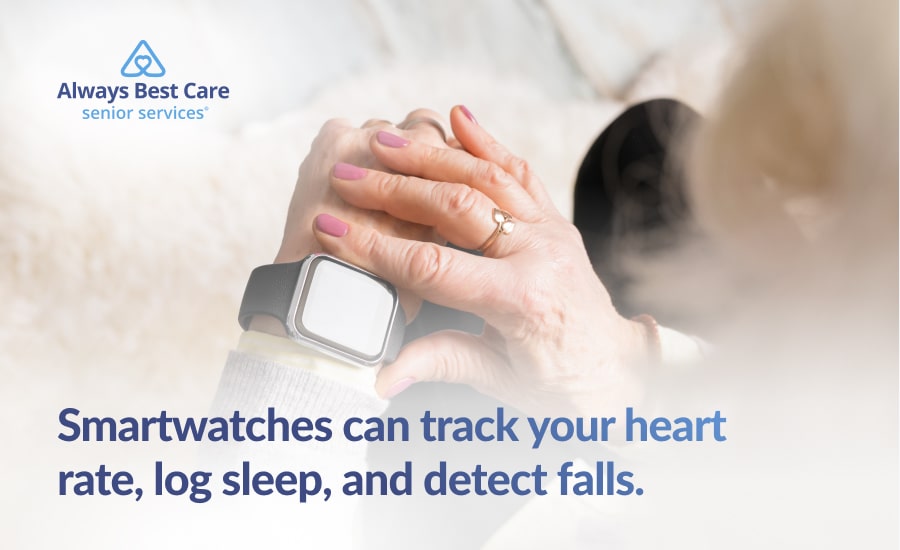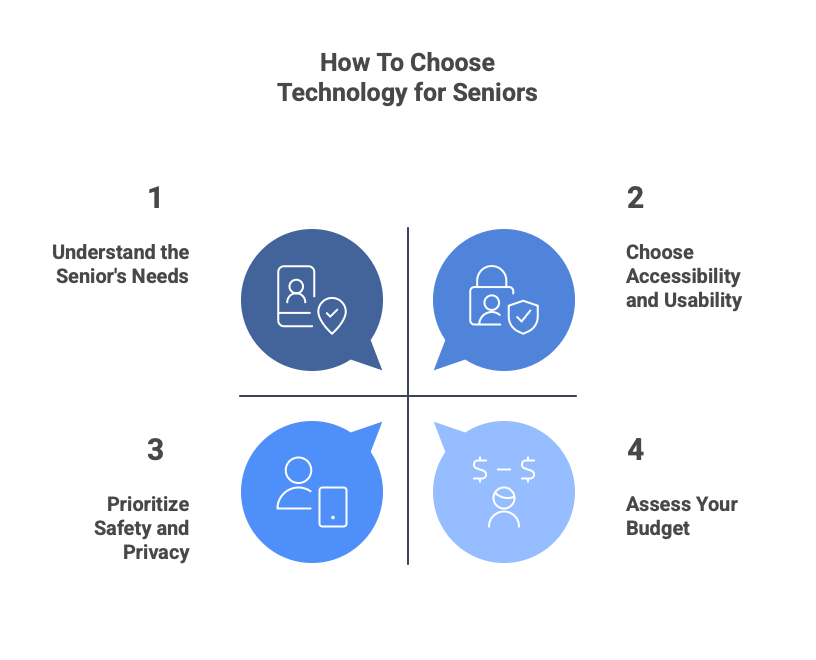10 Senior Living Technologies You Should Know About [+ FAQs]
![10 Senior Living Technologies You Should Know About [+ FAQs]](https://cdn.alwaysbestcare.com/wp-content/uploads/2025/06/senior-living-technology-hero-image.jpg)
Table of Contents
Senior Living Technology: Key Takeaways
- Senior living technology includes VR headsets, personal emergency response systems (PERS), voice assistants, and wearable health trackers
- Assisted living technology also covers video doorbells for added security and robotic vacuums to ease daily chores
- Most private insurance plans don’t cover elderly care technology, but it’s still worth checking with your provider
According to a study, older adults who lack support are more likely to experience memory loss and faster cognitive decline.
With more seniors choosing to age in place, the right technology is a lifeline for keeping minds sharp and routines consistent.
In this guide, we will:
- Discover senior-friendly tech tools that make daily life safer, easier, and more enjoyable
- Find answers to common questions about how senior care technology can support aging in place
- Share expert in-home care from Always Best Care that complements and enhances tech solutions for seniors
Top Senior Living Technologies That Make Life Easier
These are the game-changing tools helping seniors stay connected, independent, and in control.
1. VR Headsets
From touring the Louvre to revisiting childhood neighborhoods, virtual reality gives seniors engaging, low-impact ways to explore, connect, and stay mentally active.
Social platforms like Meta Horizon add another layer of connection by offering virtual communities that help ease feelings of isolation.
To ensure a positive experience, it’s important to keep the following in mind:
- Headsets should be lightweight and easy to use.
- Interfaces should be intuitive for first-time users.
- Introduce VR gradually, especially for those sensitive to motion.
2. Personal Emergency Response Systems
Did you know that approximately one in four adults over 65 fall each year? That’s why having quick, reliable access to help is essential, especially in emergencies.
PERS devices provide 24/7 help at the press of a button, with key features such as:
- Automatic fall detection
- GPS tracking
- Two-way communication
Finally, when choosing a system, consider the following:
- Reliable cellular coverage
- Long battery life
- Comfortable, wearable designs
- Smartwatch integration for added convenience
3. Tablets
Senior-friendly tablets like GrandPad make it easy to get online, video chat with loved ones, and enjoy apps for reading, games, and streaming.
Designed with accessibility in mind, these tablets often include:
- Large, easy-to-read icons
- Voice input for hands-free navigation
- Stylus support for added ease, especially for those with mobility or vision challenges
4. Video Call Applications
Social isolation and loneliness increase the risk of heart disease, depression, and cognitive decline, according to a WHO report.
To stay connected and engaged, many seniors are turning to video apps like Zoom, FaceTime, and WhatsApp for:
- Virtual health visits
- Group activities like book clubs
- Religious services and community events
These platforms offer a simple, effective way to combat loneliness and support mental well-being.
5. Voice Assistants
Voice assistants like Alexa, Google Assistant, and Siri can help seniors:
- Control lights and other smart devices
- Play music or check the weather
- Set reminders and alarms
They can also provide companionship by answering questions, telling jokes, or playing games.
6. Wearables
Smartwatches and fitness trackers like the Apple Watch and Fitbit can monitor heart rate, activity, sleep, and even detect falls.
Many also include SOS alerts that instantly notify emergency contacts.
In addition to health monitoring, these devices encourage healthy habits by:
- Tracking fitness goals
- Sending gentle reminders to move or stay hydrated
- Offering positive reinforcement to build routines

7. Smart Medication Dispensers
Keeping track of multiple prescriptions, especially with different dosages and schedules, can be overwhelming.
These smart dispensers offer a reliable way to simplify the process thanks to:
- Built-in alarms and visual cues to remind seniors when to take their vitamins or prescribed medications
- Locked compartments that release only the correct dose at the right time
- Connectivity features that alert caregivers if a dose is missed
8. Hearing Aids With Bluetooth Capability
Modern hearing aids are packed with smart features that make daily life easier, such as Bluetooth streaming for calls and music, noise reduction for clearer conversations, and remote adjustments by audiologists.
With Bluetooth connectivity, users can stream phone calls, music, or TV audio straight to their hearing aids, removing the hassle of juggling volume settings on multiple devices.
Assisted Living Technologies for a Safer Home
Creating a safer home for aging loved ones starts with the right senior care technology, including:
9. Video Doorbells
As safety needs grow with age, elderly care technology offers added peace of mind.
Video doorbells allow seniors to:
- See and speak to visitors from a phone or tablet
- Stay safely in bed or seated while checking who’s at the door
Smart security systems can provide:
- Motion alerts for unexpected activity
- Direct connection to emergency services (in some models)
Many seniors also link their systems with home care services for additional support during suspicious events, such as potential theft.
10. Robotic Vacuum Cleaners
When bending or lifting becomes difficult, tasks like vacuuming can quickly turn into a burden.
Robotic vacuums, like Roomba or Roborock, offer a hands-free way to keep floors clean with minimal effort.
Key benefits include:
- Scheduled cleaning: Set them to run automatically on specific days or times
- Smart navigation: Built-in sensors help them avoid furniture, walls, and stairs
- Remote control: Manage them through a smartphone app or with voice commands via Alexa or Google Assistant

How To Choose the Best Technology for Seniors
Finding the right tech for seniors starts with understanding what truly supports their lifestyle.
Here’s how to make the best choice:
1. Understand the Senior’s Needs and Comfort Level
People are likely to abandon tech that doesn’t match their lifestyle or abilities.
Before choosing a device, consider the following questions:
- What are their day-to-day pain points or desires? (think missing loved ones or remembering medication)
- Are there health limitations, such as visual impairments?
- What’s their experience level with digital devices?
2. Prioritize Accessibility and Usability
Age-related changes, such as reduced vision, hearing, or dexterity, can make standard tech difficult to use.
Look for innovations that have:
- Simple, clutter-free interfaces, as seniors are more likely to stick with tools that feel intuitive
- Voice commands that bypass the need for typing
- Easy-to-read displays and touch-friendly designs

3. Prioritize Safety and Privacy
For seniors, the right technology should empower them and help protect themselves from scams, data misuse, and confusion.
Choosing tech with built-in safety features and clear privacy settings offers peace of mind, for both seniors and their families.
4. Check for Support and Training Resources
New technology can be empowering, but without support, it often feels like a dead end.
Prioritize technology that offers strong support and is easy to adopt. Look for:
- Devices with accessible help desks or live customer service
- Brands that provide in-person tutorials or guided setup
- Products designed specifically for seniors, like GrandPad or Jitterbug phones
5. Evaluate Budget and Long-Term Costs
Look beyond the sticker price and consider ongoing costs like subscriptions, accessories, or potential repairs.
Ask yourself, is the device durable and future-proof, or will it need frequent upgrades?
Choosing cost-effective tech ensures it remains a practical, long-term solution, not a short-term burden.

Get the Support Your Elderly Loved One Needs at Always Best Care
The right technology can be life-changing for seniors. But with so many gadgets out there, it’s easy to feel overwhelmed by the choices.
At Always Best Care, we understand the anxiety family members can face when their elderly loved one starts needing extra support, especially when living alone.
That’s why we provide personalized in-home care designed to bring peace of mind, ensuring seniors receive the assistance they need while maintaining their dignity, independence, and comfort.
Senior Living Technology: FAQs
How can technology improve safety for seniors living alone?
Technology can offer helpful support for seniors living independently.
Devices like fall detectors, medication reminders, and smart locks or lights can make daily routines safer and more manageable.
Some tools also share location updates or send alerts to caregivers if something seems off, adding a layer of reassurance without being intrusive.
Are there affordable options for senior-friendly technology?
Yes. Many companies offer budget-friendly devices designed for seniors, and some insurance plans or senior services may help cover the cost. Be sure to check both upfront prices and any ongoing fees.
Does private insurance cover medical alert systems?
Typically, private insurance doesn’t cover the cost, but it’s a good idea to ask your provider. In some cases, you might qualify for partial reimbursement with a doctor’s note or the right paperwork.
Can caregivers or family members manage the tech remotely?
Yes. A lot of senior-focused tech includes caregiver apps or online portals, letting loved ones monitor health stats, receive alerts, and adjust settings, usually with the senior’s permission.
Where can I find trusted reviews or recommendations?
Great sources include AARP and senior tech forums.
You can also read verified reviews from other caregivers or ask for advice at local aging support centers.





